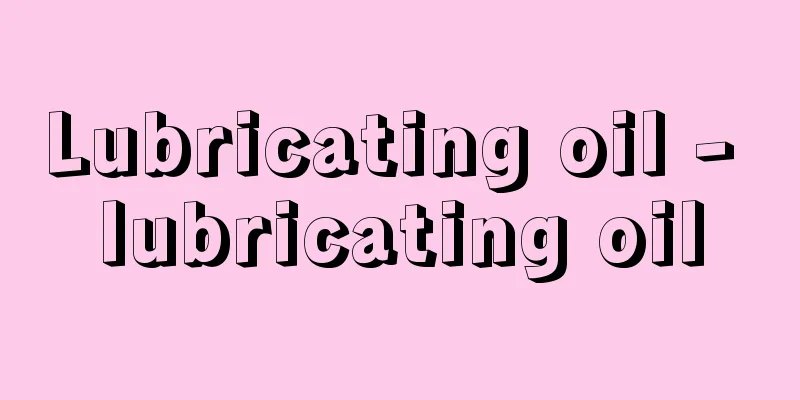Lubricating oil - lubricating oil

|
This refers to a liquid type of lubricant. When two objects move in contact with each other, the resistance that tries to impede that movement is called friction. Lubricating oils, sometimes simply called oils, are used to reduce this frictional force and remove the heat generated by friction. In addition to reducing friction and cooling, lubricating oils also have stress dispersion, sealing, corrosion prevention, and dust prevention functions. [Namba Seitaro] kindsMost of the time, the base oil is petroleum-based mineral oil, but synthetic oil, animal and vegetable oil, and even blends of these with mineral oil can also be used. There are many types of lubricants, each of which has its own standard set by the JIS (Japanese Industrial Standards), but many are sold by lubricant manufacturers under their own product names. There are many types of lubricants because there are a wide variety of machines that require lubricants, and the operating conditions of the machines are also very diverse. The basic properties required are (1) appropriate viscosity at the operating temperature, (2) high viscosity index (small change in viscosity due to temperature), (3) stable oil film even under boundary lubrication conditions, and (4) stability against heat and oxidation. Since the 1990s, many oil manufacturers have begun to sell synthetic lubricants in response to the demand for higher performance lubricants. Dibasic acid diesters for aircraft jet engines are a typical example. [Namba Seitaro] Manufacturing methodThe main raw material for petroleum-based lubricants is the residual oil from atmospheric distillation of crude oil. Many lubricants are made by refining the residual oil, which has a boiling point of 300°C or higher, obtained by vacuum distillation, into a base oil. When naphthene-based crude oil is the starting raw material, refining is generally done by sulfuric acid washing and clay treatment (or hydrotreating). This process removes sulfur, nitrogen, oxygen compounds, polycyclic aromatics, resins, and asphalts (which reduce thermal and oxidative stability). When paraffin-based crude oil is the starting raw material, refining is done by solvent extraction, solvent dewaxing, and hydrotreating (or clay treatment) to remove the aforementioned substances that reduce thermal and oxidative stability, as well as wax (which increases the pour point and reduces the viscosity index). Lubricants made from paraffin-based crude oil are base oils with high viscosity indexes, and high-grade lubricants (typical examples are engine oil and turbine oil; machine oil is classified as a standard lubricant) are made from them. High viscosity (more viscous than starch syrup) lubricating oil is made from refined vacuum distillation residual oil (asphalt and heavy metal compounds are removed by solvent extraction). [Namba Seitaro] AdditivesLubricating oils are usually made from the aforementioned base oils (in many cases, the viscosity is adjusted by blending base oils of different viscosities) or, if necessary, base oils to which additives have been added. Additives include antioxidants, corrosion inhibitors, detergents and dispersants, extreme pressure agents (to prevent seizure and wear at high temperatures), rust inhibitors, viscosity index improvers, pour point depressants, and antifoaming agents. [Namba Seitaro] [Reference] | |©Shogakukan "> Petroleum-based lubricant manufacturing process Source: Shogakukan Encyclopedia Nipponica About Encyclopedia Nipponica Information | Legend |
|
潤滑剤のなかで液状のものをいう。二つの物体が互いに接触して運動するとき、その運動を妨げようとする抵抗が摩擦である。この摩擦の力を減少させ、摩擦により発生する熱を除去する目的で用いるのが潤滑油で、単にオイルとよばれることもある。潤滑油は減摩、冷却の作用以外に、応力の分散、密封、防食、防塵(ぼうじん)の作用がある。 [難波征太郎] 種類石油系鉱油を基油とする場合がもっとも多いが、合成油、動植物油、さらにこれらと鉱油との配合油を基油とすることもある。潤滑油の種類は非常に多く、それぞれについてJIS(ジス)(日本工業規格)で規格が定められているが、多くは潤滑油製造業者が独自の商品名をつけて市販している。潤滑油を必要とする機械類は多岐にわたるうえ、機械類の作動条件も千差万別であることから種類が多くなっている。基本的に必要な性質は、(1)使用温度において適当な粘度を有する、(2)粘度指数が大きい(温度による粘度変化が小さい)、(3)境界潤滑の状態でも油膜が安定している、(4)熱や酸化に対して安定なこと、などである。1990年代以降は、より高性能の潤滑油の要求に対応して多くのオイルメーカーから合成潤滑油が販売されるようになった。航空ジェットエンジン用の二塩基酸ジエステルは代表的な例である。 [難波征太郎] 製造法石油系潤滑油の主原料は、原油の常圧蒸留の残油である。多くの潤滑油はこの残油を減圧蒸留して得られる沸点300℃以上の油を精製して基油としている。ナフテン基原油が出発原料であるときの精製は、一般に硫酸洗浄、白土処理(あるいは水素化処理)である。この操作により、硫黄(いおう)、窒素、酸素化合物、多環芳香族、樹脂分、アスファルト質(これらの物質は熱安定性、酸化安定性を低下させる)が除去される。パラフィン基原油が出発原料であるときは、溶剤抽出、溶剤脱ろう、水素化処理(または白土処理)による精製を行い、前述の熱安定性、酸化安定性を低下させる物質およびろう分(流動点を高く、粘度指数を小さくさせる)を除去する。パラフィン基原油から製造される潤滑油は高粘度指数の基油であり、これから高級潤滑油(エンジン油、タービン油などが代表的なものである。これに対し、マシン油は並級潤滑油に分けられる)が製造される。高粘度(水飴(みずあめ)より粘稠(ねんちゅう))潤滑油は減圧蒸留残油を精製(溶剤抽出によりアスファルト分、重金属化合物を除去)したものが基油となる。 [難波征太郎] 添加剤通常、潤滑油は、前述の基油(多くの場合は粘度の異なる基油を配合して粘度を調節している)そのもの、または必要に応じて基油に添加剤を加えたものである。添加剤としては酸化防止剤、腐食防止剤、清浄分散剤、極圧剤(高温での焼付き、摩耗を防止する)、さび止め剤、粘度指数向上剤、流動点降下剤、消泡剤などがある。 [難波征太郎] [参照項目] | |©Shogakukan"> 石油系潤滑油の製造工程 出典 小学館 日本大百科全書(ニッポニカ)日本大百科全書(ニッポニカ)について 情報 | 凡例 |
Recommend
Lydia Koidula
1843‐86 Estonian poet. Showing talent for poetry a...
North German Lloyd Steamship Company - Kitadoitsu Lloyd Steamship
…However, after the 1850s, when steamships first ...
Masatoshi Hotta
Year of death: 28th August 1684 (7th October 1684)...
Prime rate (English spelling)
The prime interest rate is the interest rate offer...
Karasawayama
A mountain located in Sano City, southwest of Toch...
Hirai Castle
Hirayama-jiro (Hirayama Castle) was located in Fuj...
hard rime (English spelling) hardrime
...It can be thought of as the same way that hail...
Kanemi Warehouse Co., Ltd. - Kanemi Souko
…An incident in which people who had consumed ric...
Nobel - Alfred Bernhard Nobel
Swedish chemist, entrepreneur, and inventor of dy...
Ooshiropinno - Ooshiropinno
→ Clown crab Source : Heibonsha Encyclopedia About...
Costume Philosophy - Sartor Resartus
A work by British historian Thomas Carlyle. As th...
Siphonosoma cumanense (English spelling) Siphonosoma cumanense
... Phascolosoma scolops are closely related to t...
Pygoscelis papua (English spelling) Pygoscelispapua
...The Magellanic penguin S. magellanicus (illust...
Kleanthes - Kleanthes (English spelling)
A philosopher of the Stoic school of ancient Gree...
Jabbaren
…The area is now a completely dry, rugged mountai...

![Edison [company] - edison](/upload/images/67cf9da19c527.webp)







